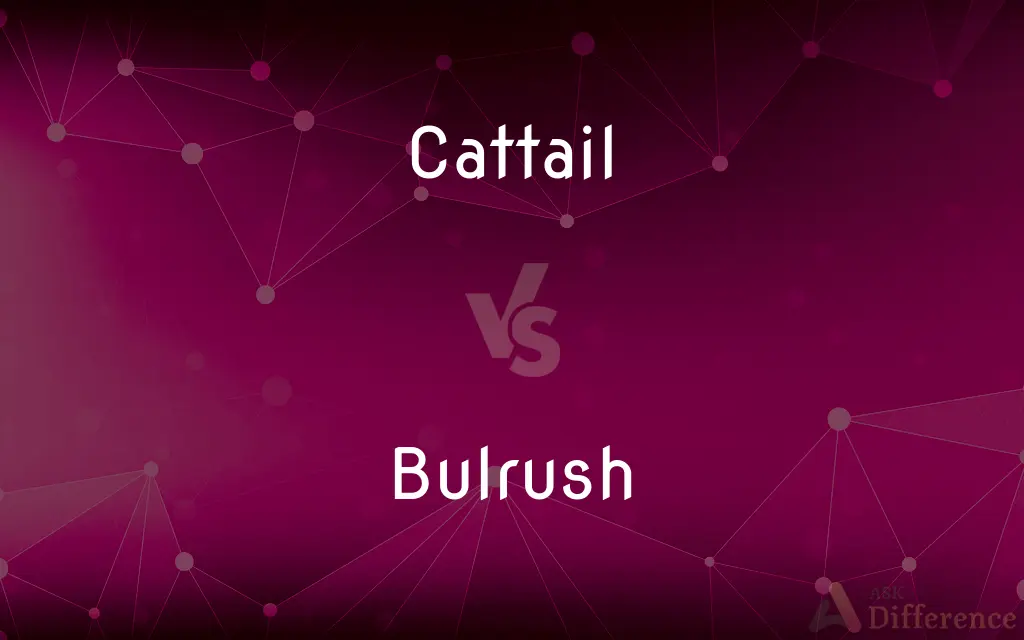Cattail vs. Bulrush — What's the Difference?
By Tayyaba Rehman — Updated on August 21, 2023
Cattail and bulrush are both wetland plants, but cattails have cigar-shaped brown spikes while bulrushes have round or oval seed heads.

Difference Between Cattail and Bulrush
Table of Contents
ADVERTISEMENT
Key Differences
Cattail and bulrush are two distinct species of wetland plants, both often found in similar habitats like marshes, ponds, and lakes. Cattails are easily recognizable by their tall, sturdy stalks topped with elongated, cigar-shaped brown spikes. On the other hand, bulrushes sport slender stems and typically have round or oval seed heads, depending on the species.
Both cattail and bulrush have been used traditionally for various purposes. Cattails, with their dense and fluffy spikes, have been utilized for insulation, while the stems have been used for weaving. Bulrushes, however, have been valued for their sturdy stems that are often woven into mats, baskets, and even roofing material.
In terms of habitat, both cattail and bulrush prefer areas with still or slow-moving water. However, cattails are more aggressive colonizers and can dominate an area quickly, often forming dense stands. Bulrushes are more tolerant of saltwater and can be found in brackish marshes, whereas cattails typically thrive in freshwater environments.
Both cattail and bulrush play crucial ecological roles. They provide habitat and food for a range of wildlife, from birds to amphibians. Their root systems help stabilize soil, preventing erosion, and they act as natural water purifiers, absorbing excess nutrients and pollutants.
Comparison Chart
Appearance
Tall with cigar-shaped brown spikes
Slender with round or oval seed heads
ADVERTISEMENT
Traditional Use
Insulation and weaving
Mats, baskets, and roofing
Growth Behavior
Aggressive colonizer
Less aggressive than cattails
Water Preference
Freshwater
Can tolerate brackish water
Ecological Role
Habitat, food, and water purification
Habitat, erosion control, and water purification
Compare with Definitions
Cattail
A plant known for its dense and fluffy seed heads
Children often break open cattail spikes to play with the fluffy seeds inside.
Bulrush
A plant with an ecological role in erosion control
The shoreline was stabilized by the deep roots of the bulrush.
Cattail
A commonly found plant in marshes and ponds
The cattail stands tall, marking the edge of the wetland.
Bulrush
A water plant that can grow in various wetland habitats
Whether in ponds or estuaries, bulrush finds a way to thrive.
Cattail
A plant with broad flat leaves and a sturdy stalk
Cattails waved gently in the breeze by the water's edge.
Bulrush
A plant often found in brackish environments
The presence of bulrush indicated the water was somewhat salty.
Cattail
An aquatic plant used for insulation and weaving
She gathered cattails to weave into a basket.
Bulrush
Known for its use in traditional crafts, especially weaving
Using bulrush, the artisan crafted a beautiful mat.
Cattail
A tall erect rush or flag (Typha latifolia) growing widely in fresh and salt marshes, with long, flat, sword-shaped leaves, having clusters of small brown flowers in a dense cylindrical spike at the top of the stem; - called also bulrush and reed mace. The leaves are frequently used for seating chairs, making mats, etc. See Catkin.
Bulrush
Bulrushes is the vernacular name for several large wetland grass-like plants in the sedge family (Cyperaceae). The name is particularly applied to several sedge family genera: Cyperus, the genus which includes the plant species likely referred to in the Biblical account of the Ark of bulrushes Scirpus, a genus commonly known as bulrushes in North America, which in previous circumscriptions has also included species now classified in the genera: Blysmus Bolboschoenus Scirpoides Isolepis Schoenoplectus TrichophorumOutside of the sedge family, the name is used for Typha, a genus in the family Typhaceae.
Cattail
A tall wetland plant with brown, cigar-shaped spikes
The pond was surrounded by dense cattails.
Bulrush
A wetland plant with slender stems and round seed heads
Bulrushes lined the saltwater marsh, bending with the wind.
Cattail
Any of several perennial herbs, of the genus Typha, that have long flat leaves, and grow in marshy places.
Bulrush
Any of various aquatic or wetland sedges chiefly of the genus Scirpus, having grasslike leaves and usually clusters of small, often brown spikelets.
Cattail
Any of various perennial herbs of the genus Typha, widespread in marshy places and having long straplike leaves and a dense cylindrical cluster of minute flowers and fruits. Also called reed mace.
Bulrush
Any of several wetland plants of similar aspect, such as the papyrus and the cattail.
Cattail
A cat-o'-nine-tails.
Bulrush
Any of several wetland plants, mostly in the family Cyperaceae (the sedges):
Cattail
Tall erect herbs with sword-shaped leaves; cosmopolitan in fresh and salt marshes
Bulrush
(Americas) Sedges in the genera Bolboschoenus or Schoenoplectus (formerly considered Scirpus), having clusters of spikelets.
Bulrush
(UK) Cattails or reedmace, in the genus Typha
Bulrush
(biblical) A plant referred to in the story of Moses as growing along the banks of the Nile, which is believed to be the papyrus (Cyperus papyrus).
Bulrush
A kind of large rush, growing in wet land or in water.
Bulrush
Tall marsh plant with cylindrical seed heads that explode when mature shedding large quantities of down; its long flat leaves are used for making mats and chair seats; of North America, Europe, Asia and North Africa
Bulrush
Tall rush with soft erect or arching stems found in Eurasia, Australia, New Zealand, and common in North America
Common Curiosities
Why are cattail and bulrush important to the ecosystem?
Both cattail and bulrush play vital roles in providing habitat, food, and assisting in water purification in wetland ecosystems.
Where can you commonly find cattail and bulrush?
Both cattail and bulrush are commonly found in wetland environments such as marshes, ponds, and lakes.
Are cattail and bulrush the same plant?
No, cattail and bulrush are distinct species, with cattails having cigar-shaped spikes and bulrushes having round or oval seed heads.
How do cattail and bulrush reproduce?
Both plants reproduce by seeds, but cattail can also spread aggressively through its rhizomes.
Can cattail and bulrush be used for crafts?
Yes, both plants have been traditionally used for various crafts, with cattail stems suitable for weaving and bulrush stems for mats and baskets.
Do cattail and bulrush have any medicinal properties?
Throughout history, various cultures have attributed medicinal properties to parts of the cattail and bulrush, although scientific evidence varies.
What are the traditional uses of cattail and bulrush?
Cattails have traditionally been used for insulation and weaving, while bulrushes have been utilized for crafting mats, baskets, and roofing.
Can cattail and bulrush grow in saltwater habitats?
While cattails typically prefer freshwater, bulrushes can tolerate brackish or slightly salty environments.
Are any parts of the cattail and bulrush edible?
Yes, certain parts of both cattail and bulrush are edible and have been consumed by indigenous peoples for centuries.
How can you differentiate between cattail and bulrush just by looking?
Cattails have tall, sturdy stalks with elongated brown spikes, while bulrushes have slender stems and round or oval seed heads.
Share Your Discovery

Previous Comparison
Summarise vs. Abridge
Next Comparison
Misery vs. HeartacheAuthor Spotlight
Written by
Tayyaba RehmanTayyaba Rehman is a distinguished writer, currently serving as a primary contributor to askdifference.com. As a researcher in semantics and etymology, Tayyaba's passion for the complexity of languages and their distinctions has found a perfect home on the platform. Tayyaba delves into the intricacies of language, distinguishing between commonly confused words and phrases, thereby providing clarity for readers worldwide.















































